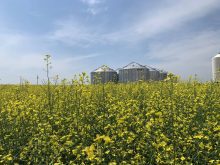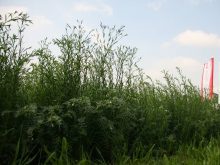Intercropping has been used for ages by farmers around the world as a way to boost overall crop production. With monocultures now dominating Prairie farms, you don’t see much of it these days. However, that could change as regenerative agriculture practices like intercropping continue to gain a foothold in Western Canada.
Colin Rosengren is a strong supporter of intercropping and of sustainable agriculture in general, and for close to 20 years he’s been trying out different crop combinations on his farm near Midale in southeastern Saskatchewan. During that time, he has come to have a pretty good idea how beneficial intercropping can be and what mixes are feasible in a Canadian Prairie context.
Rosengren shared his intercropping experiences at Farm Forum Event 2021. Here’s what he had to say about two crop combinations, canola and field pea and chickpea and flax, which have become a staple for his operation.
Read Also

Claas brings 1000 Series SP forage harvesters to Canada
In mid-August, Claas unveiled its new line of Jaguar forage harvesters at an event in Visalia, California, deep in the heart of that state’s dairy region.
Canola and field pea
This was the first intercrop mix Rosengren started with in 2004. He says he chose the canola and field pea mix because it was “easy, low-hanging fruit,” and since then, he’s had a lot of success with it. “I think we’ve done it every year. It works well together.”
Rosengren says growing the two crops together provides a 20 to 30 per cent yield boost, and there are several other things he likes about the canola and pea combination — it’s an easy mixture to manage and maturities generally come in well, producing a crop that stands up and harvests well too.

“Straight cutting is a dream with that mix,” says Rosengren. “The peas even help to hold the canola together, so you don’t get shattering in the wind. We’ve done it for a number of years before there were even straight-cut canola varieties, so (we’re) pretty confident that’s a good crop to let stand and straight cut at harvest.”
Rosengren says like for most of his intercrop projects, he’s learned a few “tricks” along the way to ensure the best chance for success of his canola and pea mix. One is taking steps to balance the competitiveness of each crop, which is one of the key principles of intercropping.
“Peas are probably a little more competitive than the canola, but (one) of the things we can do to skew that yield more towards the canola and less towards the peas is to change the seeding depth. Especially early in the year when the soils are cool, if you get the peas down two or three inches the soil is cooler than it is up at the half-inch depth,” says Rosengren.
By varying the seeding depth this way, the two crops can be seeded together but the canola will emerge a few days earlier, he adds. “That head start gives it that little bit more competitiveness and will bias your crop to (have) a little more canola production at the expense of some peas.”
Rosengren found a few more management tweaks for controlling plant populations within a canola and pea mix. For example, he determined boosting nitrogen fertilizer will increase the canola population at the expense of the peas to a certain degree. “We’re trying to get both crops to do well, but sometimes we steer it a little more one way or the other (depending) on the economics of the year.”
Last year, Rosengren tried another tactic, which was to apply Odyssey herbicide a little later than he normally would. “In going just that touch later, you can create a bit of injury in your peas and, in this case, it doesn’t hurt the canola. The canola gets that little bit of a leg up … to establish a little better,” he says.
Rosengren offers this advice for farmers who want to try a canola and field pea mix on their farms. Start with about two-thirds of the normal seeding rate for both canola and peas and try to ensure the amount of available nitrogen in the soil (the combination of what’s already there and what you apply) is 40 pounds per acre.
“That will be more than enough to start the peas off and … yet not too much to stop them from getting the rhizobia established and fixing nitrogen for themselves. That’s a guideline we like to use on our land and our fields,” says Rosengren.

Chickpea and flax
Another intercrop mainstay for Rosengren is chickpea and flax. He says the reason he decided to combine chickpea and flax was to address problems he was having with each crop.
Flax needs phosphorus to thrive, but there isn’t much of it in the soils on Rosengren’s farm. “(Flax) is not good at scavenging phosphorus out of the soil (and) it’s not good at uptaking phosphorus you apply as fertilizer in the year of production. No matter what you put on it’s really tough to get it into that crop and then tough to get a really strong yield of flax for us in this area,” he says.
The issue Rosengren was having with chick- pea on his farm is ascochyta blight could be a real problem in wetter years. “You end up spraying multiple times and it starts to feel like the definition of insanity — you keep spraying and spraying and spraying with fungicide four or five, six, seven times in a year and it just comes back and back and back,” he says.
What Rosengren did was seed the chickpea and flax mix in alternating, paired rows, so two rows of chickpeas, then two rows of flax, and so on. He had to make some modifications to his planting equipment to be able to do this. Depending on machinery type, there are many ways farmers can modify planting equipment to fit their seeding operations, he adds.
Rosengren found by arranging the crops in this way, the flax created a barrier or firewall that helped prevent ascochyta from rapidly spreading in the chickpeas.
“We can’t stop the incidence or the initial infection points in the field, but what we can do is greatly slow down that spread, which then stops it from acting like wildfire and spreading across the entire field,”says Rosengren.“ (This allows) you to manage it, giving you some time before you need to spray because it’s not devastating your entire crop immediately. That’s been a really big one for us.”
This setup also provides a solution for the phosphorus-deficient flax. “Chickpeas are the best scavenger crop there is as far as (mining) nutrients out of the soil,” Rosengren says. “They’ll find more (phosphorus) than any other crop can.”
What happened in Rosengren’s field is the chickpeas were able to share some of the phosphorus with the flax through their root systems with the help of arbuscular mycorrhizal fungi in the soil, which act as a transfer agent.
Rosengren says when he first started growing the chickpea and flax mix, the flax really took off and was outcompeting the chickpea, so he tried different seeding rates and nitrogen application rates to address this. What he’s doing now is to seed about 15 pounds of flax per acre in the crop mix and he doesn’t apply any nitrogen, which Rosengren says still produces a strong flax yield.
Because of the dual benefits the chickpea and flax mix offers, it has “become a real no-brainer for us…. We find (the flax) needs the chickpea and the arbuscular mycorrhizal fungi to actually be able to excel, and the chickpeas also need the flax in there to break that disease and do well.”
Rosengren says the chickpea and flax combination has “worked amazingly well” with strong yields and lower input costs since the crop only needs to be sprayed the odd year when environmental conditions are really wet and there is high disease pressure. “We’ll take that one as quite a success story and continue to do it,”he says.
















